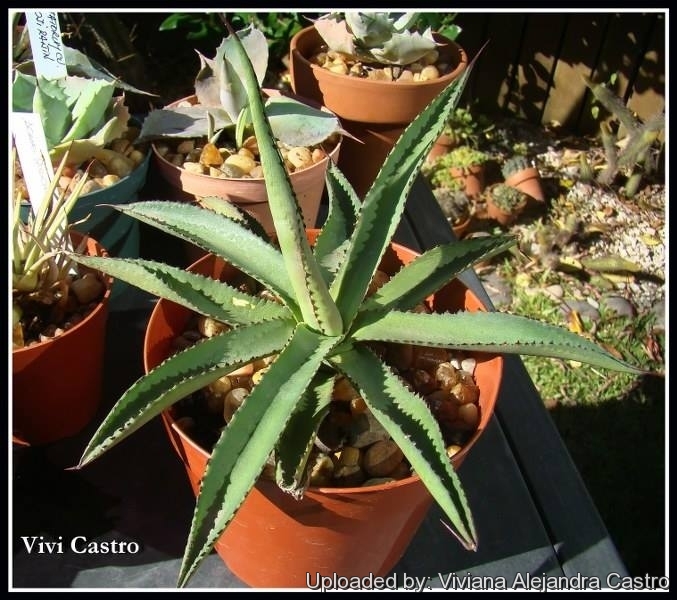




Your support is critical to our success.

Origin and Habitat: Agave boldinghianaSN|299]]SN|299]] is a Caribbean species known only from Bonaire and Curacao of the Leeward Islands (West Indies); the type from Curacao.
Note: The ecotype from Bonaire isl. has more crowded and smaller spines and – perhaps - varietally separable.
Synonyms:
- Agave boldinghiana Trel.
ENGLISH: Koeki, Koeki spanjool, Koeki indian
Description: Agave boldinghiana is a very attractive, nearly stemless, medium sized agave forming rosettes with dark red spines on the leaves even from a very young age. It offsets freely and form crowded mounds. This is a member of the section Viviparae and like other members of that group produces plantlets, also technically known as bulbils, in the inflorescence.
Leaves: Green, transiently somewhat glaucous, narrowly oblanceolate, subacuminate, openly concave, 90-125 cm long and up to15 cm wide (but variably broad). The leaf margins irregularly toothed, with strong triangular spines from a half-moon-shaped base, at first scarlet becoming chestnut, mostly 10-15 mm apart, 4-7 mm long, often irregularly upcurved above and recurved below, the intervening margin rather straight. Terminal spine red-brown, smooth, polished toward the end, somewhat upcurved-flexuous, needle-like, grooved and usually involute toward the base, 25-30 mm long and 2-5 mm in diameter, shortly decurrent.
Inflorescence: Slender, about 5 m high, the upper half or less narrowly oblong-paniculate with few irregularly arranged, ascending branches. Bracts narrowly triangular, rather distant, appressed. Pedicels 5 mm long. The flower spikes come out from the leaf axils near the centre of the rosette and produces flower for about 8 months. The rosettes are not apparently monocarpic. After blossoming, bulbils (already formed tiny plants) form on the inflorescence. The bulbils fall to the ground, giving life to a new colony of Agaves.
Flowers: Golden yellow, 45 mm long in the upper part of the inflorescence. Ovary broadly spindle-shaped 20-25 mm. long, equaling the perianth. Flower tube conical, about 7 mm long; segments 4 by 15 mm, shorter than the ovary; filaments inserted nearly in the throat, about 35 mm long and twice as long as the segments.
Fruits and seeds: Not known.
Bibliography: Major references and further lectures.
1) William Trelease: “Agave in the West Indies.” In: Memoirs of the National Academy of Sciences. volume 11, 1913, page 21, tab. 11–13
2) J. Thiede: Agavaceae. In: Urs Eggli “Illustrated Handbook of Succulent Plants: Monocotyledons: Monocotyledons” Springer Science & Business Media, 17/Jul/2001
3) A. Berger: “Die Agaven” Gustav Fischer Verlag Stuttgart. 1915, page 225–226.
4) P. W. Hummelinck: “Notes on Agave in the Netherlands West Indies and North Venezuela.” Recueil Trav. Bot. Neerl. volume 35: 14–28. 1938
5) P. W. Hummelinck: “Agaven op Carucao, Aruba en Bonaire 1-3.” In: Succulenta, 1993, volume 72, Number 1, page 5-11, Number 3, page 104–109, Number 5, page 214–233.
6) I. Richter: “Die Gattung Agave” A.I.A.S. 2011, page 96.
Cultivation and Propagation: Agave boldinghianaSN|299]]SN|299]] is a stunning, stable, specimen plant for containers, but seldom seen in cultivation. In milder climates this plant grows well outdoor in full sun (Light shade or eastern exposure in hot areas), plant in deep well drained soil where the climate is suitable ( coastal zones and islands). The plants in pot tend to be slow grower, but worth the effort. It is better to use wide pots which allow space for the roots of the Agave boldinghianaSN|299]]SN|299]]ato grow.
Growth rate: Agave boldinghianaSN|299]]SN|299]] is relatively slow growing, taking several years to reach flowering size.
Soil: Plant in well-drained soil.
Repotting: Every two years the pots should be changed, shortening the roots and eliminating the buds which suck the goodness from the plant, limiting its growth.
Exposure: Full sun or light shade or eastern exposure in hot low desert areas.
Waterings: Water thoroughly when soil is dry to the touch. In winter watering this plant can be done once every 1-2 months, there is no need to mist the leaves. The blue-and blue-gray-leaved forms are from very arid areas, and once established in ground the plants should be kept dry to prevent any potential rot. The blue-green-leaved form is from slightly more moist areas, and will tolerate extra water.
Hardiness: Agave boldinghianaSN|299]]SN|299]] can tolerate nighttime air temperatures of -6° C when droughted but not if watered and it is best to avoid freezing temperatures.
Heat Tolerance: Excellent.
Propagation: Agave boldinghianaSN|299]]SN|299]] can sexually reproduce by seeds and propagate vegetatively by aerial bulbils and ground-level basal shoots and rhizomes. It suckers, but nearby ( not an aggressive spreader in the garden).Remove the basal suckers in spring or summer and let the cuttings dry for a few days before inserting in compost. only problem is the logistics of getting to the suckers - very sharp spines and suckers usually right up against, or underneath the mother plant.
Uses: These striking plants are wonderful when used for accent or simply to provide some all year round foliage colour and often used in a pot as a patio plant, they make an eye-catching statement and along with other evergreen plants in pots, can be moved around to change the scenery or position to give more shelter.
| Your Actions | |
|---|---|
| Back to Agave index | |
| Back to Agavaceae index | |
 |
Back to Succulents Encyclopedia index |
Privacy stantement - Terms and conditions - How to cite - About us - Feedback - Donate



